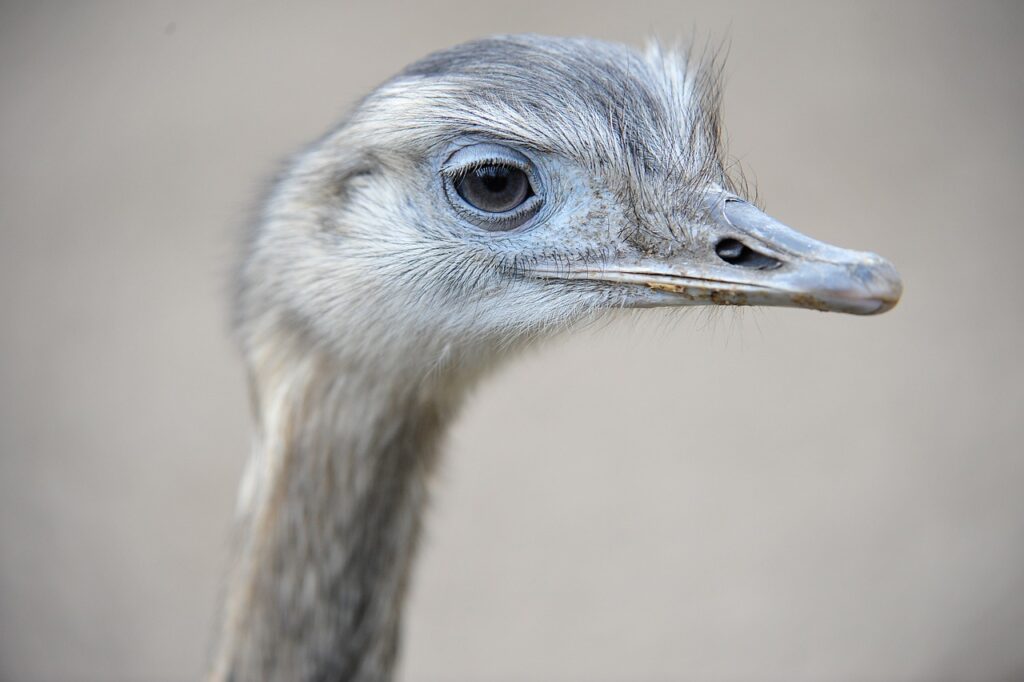The evolution of the emu and ostrich lineages can be traced back to the Late Cretaceous period, about 80-90 million years ago, when the supercontinent Gondwana was still intact. During this time, the ancestors of the emu and ostrich lived on Gondwana, which comprised what is now South America, Africa, Antarctica, Australia, and Madagascar.
As Gondwana began to break apart and the continents drifted away from each other, the ancestral ratites became isolated and evolved into different species. The ancestor of the emu evolved in Australia, while the ancestor of the ostrich evolved in Africa.
Today, the emu is found only in Australia and is the largest bird in the country, while the ostrich is native to Africa and is the largest bird in the world. These two species are closely related and are the largest living members of the Ratite group, but they have evolved distinct differences in their physical and behavioral adaptations to their specific environments.
Emus and ostriches belong to the group of flightless birds known as ratites, which means they have a flat breastbone that does not support the muscles required for flight. This group of birds also includes other flightless birds such as kiwis and cassowaries.
Like other flightless birds, emus and ostriches must find places on the ground in which to lay their eggs. They will not be able to build a nest in a tree or on a cliff. They actually dig holes in the ground and construct their nests slightly underground. When you see the birds ducking their long necks and putting their beaked heads below the surface, they are doing this to check on their babies and also to rotate the eggs to make sure they stay warm enough!
First, let’s talk about emus. Emus are pretty big birds. They stand up to 7 feet tall and can weigh as much as 150 pounds. They have small, discreet wings and have three toes on each foot. Emus’ eggs are coloured dark green and can weigh from 1 to 1.4 pounds. They have an even dark colour all over their face, neck, and feet. Emu females grow black feathers on their heads and the bare skin on their heads turns blue during mating season. Emus only live around 10-20 years. The oldest emu ever recorded was 38 years old. Emus are a bit slower than ostriches, running at top speeds of 30 miles per hour. They are usually herbivores that eat seeds, fruits, and flowers. They may eat the occasional insect if the chance presents itself. An emu’s wings are more difficult to spot than an ostrich’s wings. One reason for this is their size: the emu’s wingspan is much smaller and their colour is more consistent.
Now, let us talk about ostriches. Ostriches are larger than emus. They can grow up to 9 feet in height and weigh as much as 320 pounds. They have larger wings with a maximum wingspan of over 6 feet. Ostriches only have two toes on each foot. Their eggs are cream-coloured and can weigh up to 3 pounds. Ostriches’ color is dark brown on the back body with white patches and pink or white on their legs, face, and neck. Male ostriches have white wing tips and females have dark brown feathers. They might also have white bellies. Ostriches can live very long lives of up to 30-50 years. In captivity, some ostriches live for over 60 years. Ostrich feet are also designed for speed, with long tendons in their feet that allow them to run up to 45 miles per hour. They eat mostly plants, but insects and small reptiles are also a part of their diet. Ostriches can easily be spotted because they often have white-tipped wings that contrast against their darkly coloured bodies.
Emus and ostriches are the largest living flightless birds, similar in appearance, and thus are often confused. Both have large eyes, charmingly dorky-looking faces, and long, slender necks and legs. The ratite family has a smaller brain-to-body ratio, meaning that these birds have smaller-sized brains and aren’t very intelligent. However, it’s not too difficult to tell these birds apart once you know what you’re looking for. They are different in size, color, habitat, and more.
About the Author

Louis Soriano
Louis is 11 years old and lives in Australia. He is currently in year 6. Louis loves reading chapter books like Harry Potter. He also enjoys swimming, basketball, and soccer, and drawing pictures. He just joined Bubots last March 2025. He now enjoys writing and is now looking forward to attending Bubots’ class every day to help him improve his writing skills.

